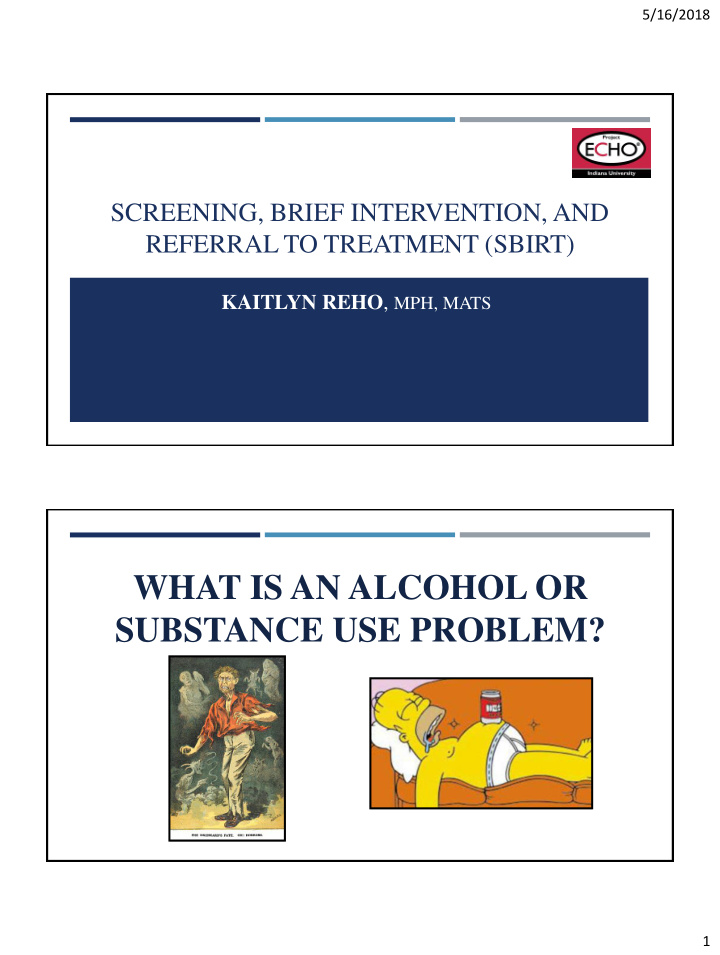



5/16/2018 SCREENING, BRIEF INTERVENTION, AND REFERRAL TO TREATMENT (SBIRT) KAITLYN REHO , MPH, MATS WHAT IS AN ALCOHOL OR SUBSTANCE USE PROBLEM? 1
5/16/2018 THE RANGE VIEW OF SUBSTANCE USE WHAT IS SBIRT? SBIRT stands for: S creening B rief I ntervention R eferral to T reatment 2
5/16/2018 SBIRT PROCESS 2-Question Alcohol and Drug Pre-screen Positive Negative AUDIT DAST-10 SBIRT Complete (10 questions) (10 questions) High-Risk/Dependent No/Low Risk Risky Brief Treatment Education and Brief Intervention and/or Referral to Reinforcement Only Treatment ADULT PRE-SCREENING How often in the past 12 months have you had 5 or more drinks (4 or more for females) in a day? How many times in the past 12 months have you used an illegal drug or used a prescription drug for nonmedical reasons? 3
5/16/2018 ADULT SCREENING TOOLS AUDIT-10 Validated for adults 18 and older Alcohol screening 10 questions on full screening DAST-10 Validated for adults 18 and older Drug screening 10 questions on full screening SCORING THE SCREENINGS AUDIT-10 DAST-10 Modality Score Score 0-7 Education and Positive Reinforcement 0 8-15 1-2 Brief Intervention 16-19 3-5 Brief Treatment 20-40 6-10 Referral to Treatment 4
5/16/2018 BRIEF INTERVENTIONS: THE NEXT STEP Short conversation or counseling session (5-15 minutes). Often focuses on barriers to changing behavior and benefits to changing. Assess readiness to change behavior. Motivational Interviewing vs. Education Only SBIRT CONVERSATIONS Establish Rapport • Raise the subject • Ask permission Thoughts and Feedback • Discuss results • Pros and cons • Health Education (when needed) Enhance Motivation • Ideas for change • Barriers to change • Validate control over the decision Negotiate a Plan • Set goals • Discuss follow-up as needed 5
5/16/2018 REFERRAL TO TREATMENT Screening locates someone on the range of substance use. Usually, a BI is used for risky/harmful use. Referral to treatment occurs when a patient uses at the heavy or dependent level , or when a BI reveals more serious use. SBIRT OUTCOMES Screening and Brief Interventions reduce … Drinking and illicit drug use 1, 3, 4 Emergency room costs 2, 3 Injuries and emergency dept. visits 3 Length of hospital stays, sick days & mortality 3 Unnecessary risks (e.g. driving under the influence, legal consequences, physical injury) 3 6
5/16/2018 REFERENCES 1. Bernstein J, Bernstein E, Tassiopoulos K, Heeren T, Levenson S, & Hingson R. (2005). Brief motivational intervention at a clinic visit reduces cocaine and heroin use. Drug and Alcohol Dependence, 77(1), 49-59. 2. Estee, S., Wickizer, T., He, L., Shah, M., & Mancuso, D. (2010). Evaluation of Washington state screening, brief intervention, and referral to treatment project: Cost outcomes for Medicaid patients screened in hospital emergency departments. Medical Care, 48 (1), 18-24 . Fleming, M.F., Mundt, M.P., French, M.T., Manwell, L.B., Stauffacher, E.A., & Barry, K.L. (2002). Brief physician 3. advice for problem drinkers: Long-term efficacy and benefit-cost analysis . Alcoholism: Clinical and Experimental Research, 26 (1), 36-43. 4. Madras BK, Compton WM, Avula D, Stegbauer T, Stein JB, & Clark HW. (2009). Screening, brief interventions, referral to treatment (SBIRT) for illicit drug and alcohol use at multiple healthcare sites: comparison at intake and 6 months later. Drug Alcohol Depend., 99(1-3), 280-295. THANK YOU! WWW.INDIANASBIRT.ORG 7
Recommend
More recommend